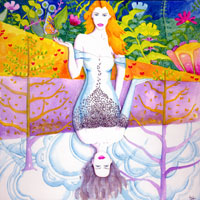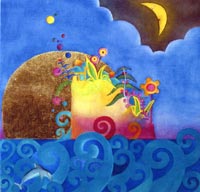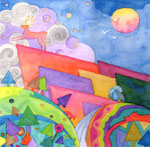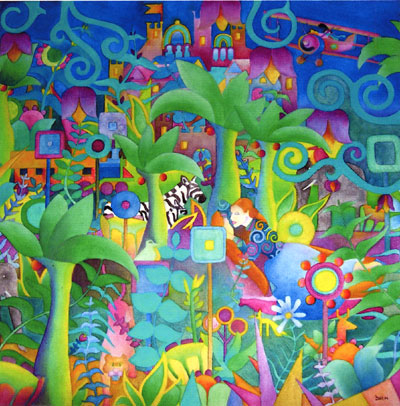
|
| DREAMS |

|
The clepsydra-woman
2000
water-colour, cm 29x29
private collection M. Camia
|

|
Flora
2001
water-colour, cm 28x28
|
Two sisters in the Customs Officer's dream
2005
acrylic, oil, alchyd on six assembled canvas, total size cm 170x150
|
"Two sisters in the Customs Officer's dream" represents the synthesis
and the reiteration of many former Bixio's works, but also the osmotic passage
from the conscious level to the oneiric one, revealing adhesion to Freud's
psychoanalytic theories. It is not by chance that the subject hints openly,
both in the structure and in the emotional alchemy, to the "Dream" by
Rousseau "the Customs Officer", including the play to dissimulate
animals in the redundant vegetation. Bixio's reference to this artist,
considered "primitive", intends to stress the consonance with his
existential and aesthetic intuition, expressed through a personalized painting
language, that could be defined as "post-naif".
|

|
|

|
The oneiric component is always present in Bixio's works: they may be dealing
with dreamed dreams or with daydreams, and the title does not necessarily makes
explicit reference to this feature. Actually, all of his works are voyages
inside the unconscious, they are mirages, desires, regrets, escapes towards
Neverland.
|

|
Neverland 1994 above
oil and gold on canvas, cm 50x50
|

|
above
An April night dream 2001
water-colour, cm 28x28
|
The lie-dream 1994 below
water-colour, cm 35x35
|

|
on the side
At dawn, thinking of an eagle lost among the apricot-trees in Gulsehir
Oteli
1993
oil on canvas, cm 50x50
private collection M. Gandolfo
|

|
on the side
Full winter night dream
1994
oil on canvas, cm 50x50
private collection P. Ivaldi
|
The representation of the Artist's dreams interlaces with others personal
sources of inspiration. In this case the reference to Shakespeare is
transparent, as well as to the painter Henri Rousseau.
It is equally evident that, around the female body, the forest is swarming with
entities: animals, objects, not immediately recognizable. An allegory of life,
in which one has to look beyond the appearance to reveal its essence.
|
|
|
